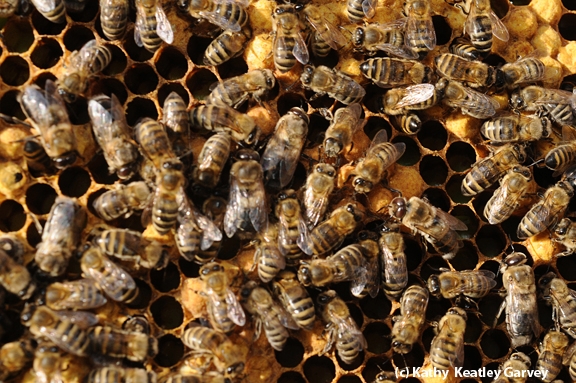With all the talk about honey bee nutrition lately, just how much food does a honey bee colony need and how far can the workers fly to find find it?
"A healthy honey bee colony requires approximately 50 pounds of pollens and 100 pounds of honey to survive for 12 months," says Extension apiculturist Eric Mussen of the UC Davis Department of Entomology and Nematology, who will speak at both the Western Apicultural Society Conference and the California State Beekeepers' Conference this fall.
"Honey production exceeding 100 pounds may be harvested as a honey crop," he says. "From spring until late fall the adult honey bee population turns over at a rate varying from an initial high of around 2000 bees a day to 1000 in the summer, and to 0 in areas with real winter."
During the peak season, a queen bee can lay 2000 eggs a day. That's a lot of mouths for the nurse bees to feed. They need food, and lots of it.
"In order to meet the nectar and pollen demands to feed all that brood (immature bees) each colony has to have an acre-equivalent of honey bee-attractive bloom within foraging flight range," Mussen says. That's up to four miles from the hive and covers a 50-square mile area.
The foraging field force of a honey bee colony, he says, usually consists of one-third of the total population. Some 40,000 to 50,000 bees comprise a colony during the peak season. The foraging population is subdivided into groups of bees specializing in collecting water, nectar or honeydew, pollen, or propolis (plant resin).
That's a lot of work for the foragers.
Here's how the numbers roll.
Statistics show that California has a total land mass of 104,765,440 acres. Of that, fresh water covers 4,949,760 acres. "The remaining 99,815,680 acres are solid ground," Mussen says.
"Our best estimate is that California beekeepers maintain 500,000 colonies of resident honey bees, the number of colonies in California swells to around 1.6 million during almond pollination."
There's plenty of food for the bees during almond pollination season, as California almond acreage totals more than 800,000. Later, though, beekeepers are looking for temporary places to put their bees.
If bees were placed on prime locations, "they would require flight access to between 1 to 1.6 million acres, or approaching a maximum of 1.6 percent of California's landmass," Mussen points out.
"The demand for honey bee forage exceeds the floral quantities in areas readily available to beekeepers. To negate the need for having to feed the colonies supplemental, artificial feed, beekeepers hope to gain access to more areas that appear to contain adequate food. Besides being expensive, artificial feed does not contain all the required nutrient or the necessary microbial complex to meet the needs of honey bees."
That's why there's a concerted drive, Mussen says, for growers to provide "more bee forage along their field edges, interplanted as cover crops, or on fallow ground that they control."
Residents can do their part, too, by providing bee friendly plants.
And that's not just food for thought. It's food for the bees.
Attached Images:


